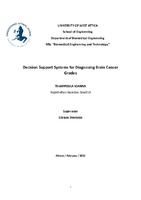| dc.contributor.advisor | Glotsos, Dimitris | |
| dc.contributor.author | Τσιαμπούλα, Ιωάννα | |
| dc.date.accessioned | 2025-03-26T07:25:43Z | |
| dc.date.available | 2025-03-26T07:25:43Z | |
| dc.date.issued | 2025-02-27 | |
| dc.identifier.uri | https://polynoe.lib.uniwa.gr/xmlui/handle/11400/8873 | |
| dc.description.abstract | Brain cancer, particularly in its advanced stage, such as glioblastoma, poses a significant threat with high mortality rates due to the complexity and vital role of the organ. The primary diagnostic method is a surgical biopsy, where all or part of the tumor is obtained for detailed histopathological examination. This method allows for the meticulous analysis of the tissue specimen, leveraging the morphological and structural distinctions between cancerous and healthy cells. Effective specimen management and the accurate determination of the tumor's degree of malignancy are crucial for tailoring appropriate treatment strategies. The present study aims to analyze and evaluate the significance of demographic and morphological characteristics obtained from the microscopic evaluation of histopathological astrocytoma specimens, to design a decision support system for more accurate and
faster diagnosis, and subsequently contribute to the decision-making process of physicians in determining suitable treatment. Statistical tests and procedures, such as Sequential Forward Selection (SFS) and Sequential Backward Selection (SBS), are used, applying various models, as well as built-in MATLAB functions such as Relief, NCA, mRMR, and Mutual Information methods. In the literature, tissue and cell characteristics are of great importance in the separation of grades overall as most of
them are correlated with each other as well as with the course of the pathology. However, demographic characteristics rarely contribute to the diagnosis but only to the prognosis and the administration of the appropriate treatment, which was demonstrated in the present study. The analysis identified specific combinations of morphological characteristics that perform optimally in classification models, suggesting potential improvements in the clinical decision-making process for diagnosing brain cancer. This study underscores the critical importance of precise specimen handling and methodological rigor in improving outcomes for brain cancer patients. | el |
| dc.format.extent | 66 | el |
| dc.language.iso | en | el |
| dc.publisher | Πανεπιστήμιο Δυτικής Αττικής | el |
| dc.rights | Αναφορά Δημιουργού - Μη Εμπορική Χρήση - Παρόμοια Διανομή 4.0 Διεθνές | * |
| dc.rights | Attribution-NonCommercial-NoDerivatives 4.0 Διεθνές | * |
| dc.rights | Attribution-NonCommercial-NoDerivatives 4.0 Διεθνές | * |
| dc.rights.uri | http://creativecommons.org/licenses/by-nc-nd/4.0/ | * |
| dc.subject | Brain cancer | el |
| dc.subject | Brightfield microscopy | el |
| dc.subject | Histopathology | el |
| dc.subject | Feature selection | el |
| dc.subject | Machine learning | el |
| dc.title | Decision support systems for diagnosing brain cancer grades | el |
| dc.title.alternative | Συστήματα υποστήριξης αποφάσεων για τη διάγνωση βαθμών καρκίνου του εγκεφάλου | el |
| dc.type | Μεταπτυχιακή διπλωματική εργασία | el |
| dc.contributor.committee | Asvestas, Pantelis | |
| dc.contributor.committee | Kostopoulos, Spiros | |
| dc.contributor.faculty | Σχολή Μηχανικών | el |
| dc.contributor.department | Τμήμα Μηχανικών Βιοϊατρικής | el |
| dc.contributor.master | Biomedical Engineering & Technology | el |


